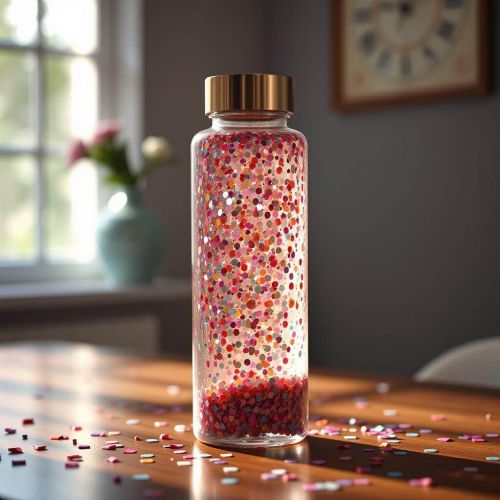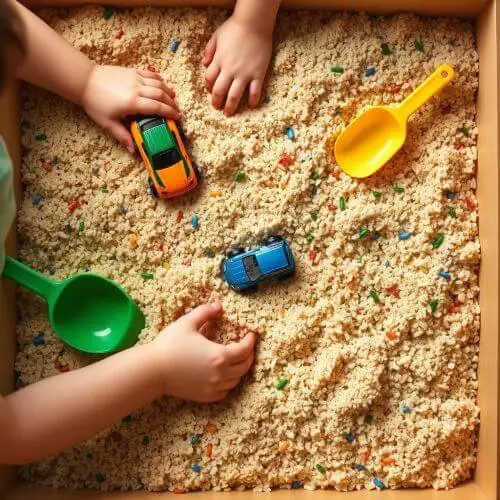Table of Contents
1. DIY Sensory Bottles
Sensory bottles are a fantastic way to engage children with autism in a visual and tactile activity. These simple, homemade bottles are soothing to look at and shake, providing calming sensory input.
Materials Needed:
- Clear plastic bottle
- Glitter, beads, small toys
- Food coloring
- Water
- Hot glue gun (to seal the bottle)
How to Make It:
Fill the plastic bottle with water, glitter, beads, or any small objects that will float or swirl. You can add a few drops of food coloring for a calming effect. Once everything is inside, seal the bottle tightly using a hot glue gun. Shake it gently, and watch the mesmerizing motion as the glitter or beads move around.

Why It’s Great:
The visual movement of glitter or beads inside the bottle can have a calming effect. The repetitive motion of shaking also provides sensory input that can help regulate emotions.
2. Stress-Relief Slime
Slime isn’t just fun—it’s also a great sensory activity! The tactile experience of squishing and stretching slime can be highly therapeutic for children with autism.
Materials Needed:
- 1 cup of cornstarch
- ½ cup of water
- Food coloring (optional)
- A mixing bowl
How to Make It:
In a mixing bowl, combine 1 cup of cornstarch with ½ cup of water. Stir the mixture until it forms a thick paste. Add food coloring if you like. Let your child squish, stretch, and play with the slime. It’s a fantastic way to engage their tactile senses and encourage fine motor skill development.
Why It’s Great:
The tactile experience of slime can be incredibly soothing. It’s a great stress reliever and can also help with sensory processing.
3. Sensory Sand Tray
A sensory sand tray provides a natural and calming texture for children with autism to explore. It can be set up quickly and customized with different small toys or materials for added interest.
Materials Needed:
- A shallow plastic tray
- Sand (play sand or kinetic sand)
- Small toys or sensory items (shells, stones, small figurines)
How to Make It:
Fill the tray with sand, making sure it’s level. Add small sensory items like shells, pebbles, or figurines. Let the child use their hands or tools to dig, pour, and explore the sand. This activity provides an opportunity for tactile exploration and helps children focus and calm down.
Why It’s Great:
The tactile experience of sand is soothing for many children with autism. It can also help with fine motor skills, as children use their hands or tools to manipulate the sand.
4. Bubble Wrap Art
Bubble wrap is not only fun to pop, but it also provides a unique texture for children with autism to explore. This craft combines both the soothing properties of the bubbles and the creativity of painting.
Materials Needed:
- Bubble wrap
- Paint (tempera or washable)
- Paper
How to Make It:
Paint a sheet of bubble wrap with your child’s favorite colors. Press a piece of paper over the painted bubble wrap and gently press down. Peel the paper away to reveal a fun print. You can make several prints or experiment with different colors and patterns.
Why It’s Great:
The tactile sensation of popping the bubble wrap and feeling the texture is highly engaging for kids. The prints made by the bubbles also provide a creative outlet.
5. Colorful Rice Sensory Bin
Colorful rice is a fantastic addition to any sensory bin. It’s soft to the touch, visually appealing, and offers endless opportunities for tactile exploration.
Materials Needed:
- White rice
- Food coloring
- Ziplock bag
- A plastic bin
- Small toys or scoops
How to Make It:
In a ziplock bag, mix rice with a few drops of food coloring. Seal the bag and shake it until the rice is fully colored. Pour the colored rice into a plastic bin and add small toys, scoops, or cups. Encourage the child to scoop, pour, or search for hidden items in the rice.

Why It’s Great:
The tactile feel of rice and the visual appeal of colorful grains help engage children’s senses. It’s perfect for sensory exploration and fine motor development.
6. Play Dough Molds
Play dough is a classic sensory material that offers endless opportunities for creativity and tactile exploration. Children with autism can use it to make shapes, squish, and stretch, helping them regulate their emotions.
Materials Needed:
- Play dough (store-bought or homemade)
- Cookie cutters or small molds
How to Make It:
Give your child a chunk of play dough and a few cookie cutters or molds. Let them roll, squish, and press the dough into different shapes. This activity can be repeated with different colors or texture patterns.
Why It’s Great:
The tactile properties of play dough help children calm down, engage their hands, and develop fine motor skills.
7. Water Beads Sensory Play
Water beads are smooth, squishy, and fun to explore. They provide a soothing experience for children with autism and are great for sensory integration.
Materials Needed:
- Water beads (available online or at craft stores)
- A shallow tray
How to Make It:
Soak the water beads in water overnight. Once they have expanded, place them in a shallow tray. Let your child feel, squeeze, and explore the beads using their hands or small tools.
Why It’s Great:
The tactile sensation of water beads provides a calming effect. They also offer a fun, squishy texture that many children find engaging.
8. Tissue Paper Collage
This easy craft encourages children to tear, glue, and create with colorful tissue paper. It’s a simple yet effective way to engage both fine motor skills and creativity.
Materials Needed:
- Tissue paper (various colors)
- Glue
- Construction paper
How to Make It:
Tear or cut the tissue paper into small pieces. Have your child glue the pieces onto a larger sheet of construction paper to create a colorful collage.
Why It’s Great:
The tactile experience of tearing and gluing tissue paper helps engage children’s hands and improve fine motor skills. The visual outcome is also very stimulating.
9. Sensory Painting with Textures
Introduce your child to the world of texture with sensory painting. Using various materials, children can create unique, textured art pieces that engage both their sense of touch and sight.
Materials Needed:
- Paint (washable or tempera)
- Various textured materials (sponges, fabric, cotton balls)
How to Make It:
Dip different textured materials (sponges, fabric, cotton balls) into paint and use them to create art. Experiment with different textures to see what the child enjoys most.
Why It’s Great:
This craft stimulates both the tactile and visual senses, helping children explore different textures and colors.
10. Paper Towel Roll Shakers
Making music with homemade shakers is a fun way to engage kids with autism. This craft provides auditory stimulation and can be used for play or calming activities.
Materials Needed:
- Empty paper towel roll
- Beads, rice, or small beans
- Tape
- Paint (optional)
How to Make It:
Fill the paper towel roll with beads or rice and tape the ends shut. Decorate the roll with paint if desired. Once it’s sealed, shake the roll to create noise!
Why It’s Great:
The auditory stimulation from the shakers helps children with sound sensitivity or regulation. The act of shaking also provides physical engagement.
Conclusion
Sensory crafts are a wonderful way to engage children with autism in a meaningful, calming way. Whether you’re working with tactile, visual, or auditory materials, these activities provide therapeutic benefits and can be easily adapted for different needs and preferences. By incorporating these 10 sensory craft ideas into your routine, you’re helping your child develop fine motor skills, emotional regulation, and creativity, all while having fun!
